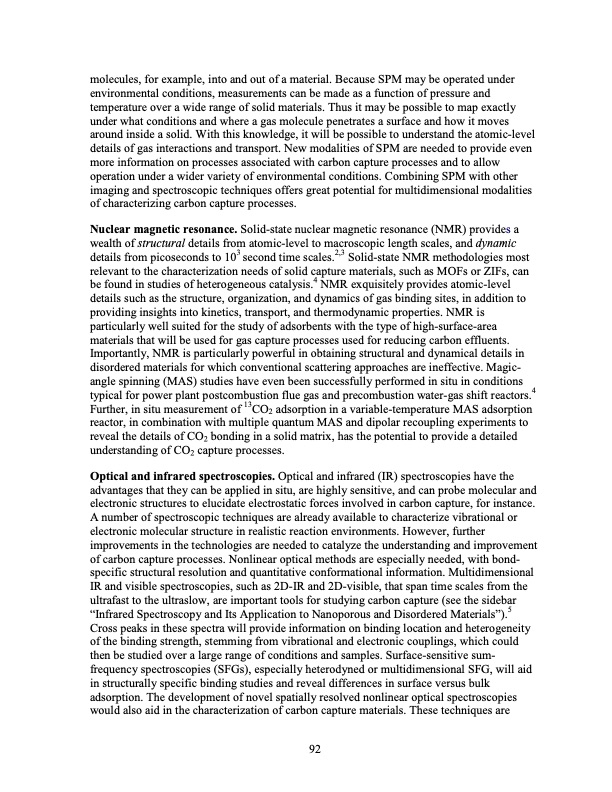
PDF Publication Title:
Text from PDF Page: 106
molecules, for example, into and out of a material. Because SPM may be operated under environmental conditions, measurements can be made as a function of pressure and temperature over a wide range of solid materials. Thus it may be possible to map exactly under what conditions and where a gas molecule penetrates a surface and how it moves around inside a solid. With this knowledge, it will be possible to understand the atomic-level details of gas interactions and transport. New modalities of SPM are needed to provide even more information on processes associated with carbon capture processes and to allow operation under a wider variety of environmental conditions. Combining SPM with other imaging and spectroscopic techniques offers great potential for multidimensional modalities of characterizing carbon capture processes. Nuclear magnetic resonance. Solid-state nuclear magnetic resonance (NMR) provides a wealth of structural details from atomic-level to macroscopic length scales, and dynamic details from picoseconds to 103 second time scales.2,3 Solid-state NMR methodologies most relevant to the characterization needs of solid capture materials, such as MOFs or ZIFs, can be found in studies of heterogeneous catalysis.4 NMR exquisitely provides atomic-level details such as the structure, organization, and dynamics of gas binding sites, in addition to providing insights into kinetics, transport, and thermodynamic properties. NMR is particularly well suited for the study of adsorbents with the type of high-surface-area materials that will be used for gas capture processes used for reducing carbon effluents. Importantly, NMR is particularly powerful in obtaining structural and dynamical details in disordered materials for which conventional scattering approaches are ineffective. Magic- angle spinning (MAS) studies have even been successfully performed in situ in conditions 4 typical for power plant postcombustion flue gas and precombustion water-gas shift reactors. Further, in situ measurement of 13CO2 adsorption in a variable-temperature MAS adsorption reactor, in combination with multiple quantum MAS and dipolar recoupling experiments to reveal the details of CO2 bonding in a solid matrix, has the potential to provide a detailed understanding of CO2 capture processes. Optical and infrared spectroscopies. Optical and infrared (IR) spectroscopies have the advantages that they can be applied in situ, are highly sensitive, and can probe molecular and electronic structures to elucidate electrostatic forces involved in carbon capture, for instance. A number of spectroscopic techniques are already available to characterize vibrational or electronic molecular structure in realistic reaction environments. However, further improvements in the technologies are needed to catalyze the understanding and improvement of carbon capture processes. Nonlinear optical methods are especially needed, with bond- specific structural resolution and quantitative conformational information. Multidimensional IR and visible spectroscopies, such as 2D-IR and 2D-visible, that span time scales from the ultrafast to the ultraslow, are important tools for studying carbon capture (see the sidebar “Infrared Spectroscopy and Its Application to Nanoporous and Disordered Materials”).5 Cross peaks in these spectra will provide information on binding location and heterogeneity of the binding strength, stemming from vibrational and electronic couplings, which could then be studied over a large range of conditions and samples. Surface-sensitive sum- frequency spectroscopies (SFGs), especially heterodyned or multidimensional SFG, will aid in structurally specific binding studies and reveal differences in surface versus bulk adsorption. The development of novel spatially resolved nonlinear optical spectroscopies would also aid in the characterization of carbon capture materials. These techniques are 92PDF Image | 2020 Carbon Capture

PDF Search Title:
2020 Carbon CaptureOriginal File Name Searched:
1291240.pdfDIY PDF Search: Google It | Yahoo | Bing
NFT (Non Fungible Token): Buy our tech, design, development or system NFT and become part of our tech NFT network... More Info
IT XR Project Redstone NFT Available for Sale: NFT for high tech turbine design with one part 3D printed counter-rotating energy turbine. Be part of the future with this NFT. Can be bought and sold but only one design NFT exists. Royalties go to the developer (Infinity) to keep enhancing design and applications... More Info
Infinity Turbine IT XR Project Redstone Design: NFT for sale... NFT for high tech turbine design with one part 3D printed counter-rotating energy turbine. Includes all rights to this turbine design, including license for Fluid Handling Block I and II for the turbine assembly and housing. The NFT includes the blueprints (cad/cam), revenue streams, and all future development of the IT XR Project Redstone... More Info
Infinity Turbine ROT Radial Outflow Turbine 24 Design and Worldwide Rights: NFT for sale... NFT for the ROT 24 energy turbine. Be part of the future with this NFT. This design can be bought and sold but only one design NFT exists. You may manufacture the unit, or get the revenues from its sale from Infinity Turbine. Royalties go to the developer (Infinity) to keep enhancing design and applications... More Info
Infinity Supercritical CO2 10 Liter Extractor Design and Worldwide Rights: The Infinity Supercritical 10L CO2 extractor is for botanical oil extraction, which is rich in terpenes and can produce shelf ready full spectrum oil. With over 5 years of development, this industry leader mature extractor machine has been sold since 2015 and is part of many profitable businesses. The process can also be used for electrowinning, e-waste recycling, and lithium battery recycling, gold mining electronic wastes, precious metals. CO2 can also be used in a reverse fuel cell with nafion to make a gas-to-liquids fuel, such as methanol, ethanol and butanol or ethylene. Supercritical CO2 has also been used for treating nafion to make it more effective catalyst. This NFT is for the purchase of worldwide rights which includes the design. More Info
NFT (Non Fungible Token): Buy our tech, design, development or system NFT and become part of our tech NFT network... More Info
Infinity Turbine Products: Special for this month, any plans are $10,000 for complete Cad/Cam blueprints. License is for one build. Try before you buy a production license. May pay by Bitcoin or other Crypto. Products Page... More Info
| CONTACT TEL: 608-238-6001 Email: greg@infinityturbine.com | RSS | AMP |